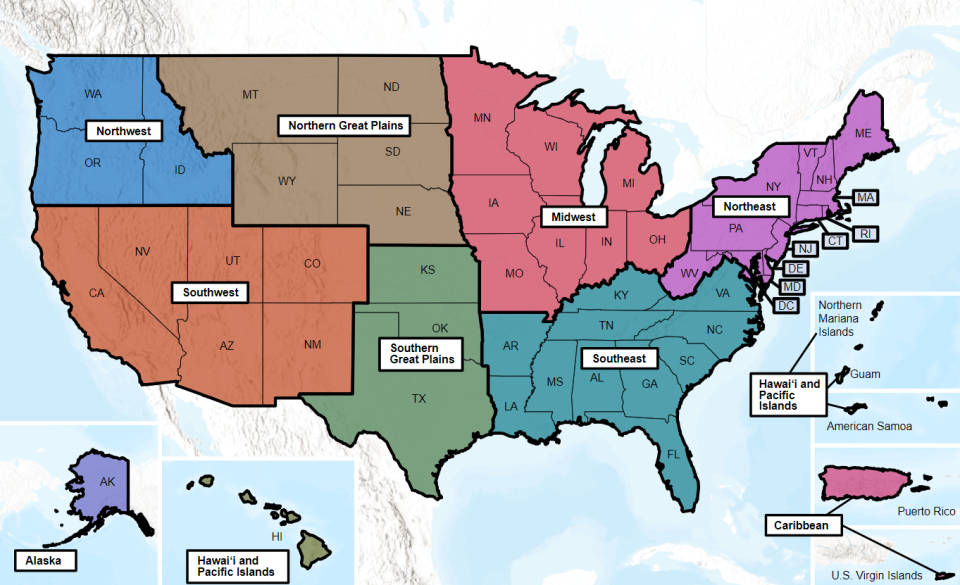Climate Change Connections: Rhode Island (Coastal Shellfisheries)
Climate change is impacting all regions and sectors of the United States. The State and Regional Climate Change Connections resource highlights climate change connections to culturally, ecologically, or economically important features of each state and territory. The content on this page provides an illustrative example. As climate change will affect each state and territory in diverse ways, this resource only describes a small portion of these risks. For more comprehensive information about regional climate impacts, please visit the Fifth National Climate Assessment and Climate Change Impacts by Sector.
On this page:
Introduction: Shellfish Have Cultural, Environmental, and Economic Importance
People have harvested shellfish from Narragansett Bay and Rhode Island’s surrounding coastal waters for thousands of years.1 Before European settlers arrived in the region, Indigenous Peoples in Narragansett Bay, including the Narragansett Indian Tribe, relied on shellfish as a food source.2 The harvesting of both wild shellfish and those raised through aquaculture remains an important part of Rhode Island’s coastal culture and economy.

The Northern quahog (also known as the hard clam) is the official state shellfish. Clams are featured prominently in local cuisine, and many people visit for Quahog Week celebrations every April.3 Nearly 400,000 pounds of wild-harvested quahogs, valued at over $4 million, were harvested from Rhode Island’s coastal waters in 2022.4
Shellfish (such as oysters, clams, and scallops) are among the primary species farmed and harvested in the wild in the northeastern coastal states.5 Aquaculture, particularly of the Eastern oyster, is one of the Rhode Island’s fastest growing and most valuable industries.4,6 In 2022, shellfish farmers and harvesters landed 68 metric tons of Eastern oysters, bringing in nearly $5.8 million in revenue.4
Climate Impacts: A Warmer, More Acidic Ocean Threatens Shellfish Stocks
Increasing concentrations of carbon dioxide in the atmosphere lead to more carbon dioxide being absorbed into the ocean. Carbon dioxide reacts with seawater to form carbonic acid, making the ocean more acidic.7 Ocean acidification affects many marine species, especially those who build mineral-based shells. As the ocean absorbs more carbon dioxide, it can be more difficult for oysters and other shellfish to build their shells. If oysters, scallops, or other shellfish are unable to build strong shells, their growth rates slow and death rates increase.7–9
Warmer ocean temperatures are also expected to increase the occurrence of harmful algal blooms (HABs) in salt water, which in turn can affect valuable shellfish stocks and human health.9 Marine HABs found in Rhode Island’s coastal waters have a variety of effects, and can cause severe neurological symptoms in humans and deaths among commercially important shellfish.9,10
Flooding and Storms Can Damage Fisheries Infrastructure
Extreme weather such as flooding and severe coastal storms can have significant impacts on fishing communities by damaging boats, equipment such as oyster trays, shellfish beds, and more.11 Rhode Island has experience with major storms like the Great Hurricane of 1938, which almost entirely wiped out the oyster industry in Narragansett Bay.12 Shucking houses, shipping wharves, and vessels were destroyed and many oyster companies never reopened after the storm. Since the 1980s, hurricanes have been intensifying more rapidly and are expected to become more intense with climate change.13 Wind and flooding can damage coastal and fisheries infrastructure, such as ports, vessels, and hatcheries. Sea level rise and storm surge events can also flood sewer systems and water treatment facilities, which can affect local water quality, potentially resulting in closures of aquaculture areas and loss of revenue for farmers.14

Taking Action: Promoting a Resilient and Sustainable Shellfish Industry
Addressing climate change requires reducing greenhouse gas emissions while preparing for and protecting against current and future climate impacts. Communities, public officials, and individuals in every part of the United States can continue to explore and implement climate adaptation and mitigation measures. While the Rhode Island and New England fishing industry faces many challenges, both climate-related and non-climate-related, there are efforts underway to build resilient and sustainable approaches, including:
- Diversifying fisheries and aquaculture. Research shows that growing seaweed and shellfish (such as kelp and mussels) in the same area may improve shellfish stock health and conditions while simultaneously bolstering the shoreline and reduce erosion from flooding and storms.11 Cultivating kelp has also been shown to enhance water quality.15 Many seafood farmers are seeking alternative adaptation practices for aquaculture, including growing species such as kelp alongside oysters or other shellfish to help improve water quality.16
- Analysis and monitoring. Adequate zoning, site selection, and risk analysis can help promote the sustainability and viability of aquaculture industries.17 Additionally, ongoing monitoring is important to understand water quality and aquaculture crop health, identify potential threats or risk factors, and ensure that shellfish populations are within suitable levels for harvesting. The Rhode Island Department of Environmental Management and the Rhode Island Department of Health monitor harmful algal concentrations that can affect both human and crop health.18
To learn more about climate change impacts in Rhode Island and the Northeast region, see Chapter 21 of the Fifth National Climate Assessment.
Related Resources
- EPA Climate Change Indicators: Ocean Acidity
- EPA Climate Change Indicators: Sea Surface Temperature
- Rhode Island Coastal Resources Management Council Aquaculture Report 2022
- Sugar Kelp (NOAA)
- Fifth National Climate Assessment, Chapter 10: Ocean Ecosystems and Marine Resources
- Rhode Island Climate Summary 2022 (NOAA)
References
1 Schumann, S. (2015). Rhode Island’s shellfish heritage: An ecological history. Rhode Island Sea Grant. https://catalog.sos.ri.gov/repositories/2/resources/176
2 Bernstein, D. J. (1991). Trends in prehistoric subsistence on the southern New England coast: The view from Narragansett Bay. North American Archaeologist, 11(4), 321–352. https://doi.org/10.2190/2P5D-097E-Y8B4-LQX5
3 State of Rhode Island Department of Environmental Management. (n.d.). Quahog Week. RI Seafood. Retrieved July 11, 2024, from https://seafood.ri.gov/quahog-week
4 NOAA Fisheries. (2023). Landings (3.16.0.7) [Data set]. Retrieved November 29, 2023, from https://www.fisheries.noaa.gov/foss/f?p=215:200:15239389896888:::::
5 NOAA Fisheries. (2024). Aquaculture in New England and the Mid-Atlantic. Retrieved July 11, 2024, from https://www.fisheries.noaa.gov/new-england-mid-atlantic/aquaculture/aquaculture-new-england-and-mid-atlantic
6 Goetsch, B. (2022). Aquaculture in Rhode Island 2022. Costal Resources Management Council. http://www.crmc.ri.gov/aquaculture/aquareport22.pdf
7 NOAA. (2020). Ocean acidification. Retrieved October 29, 2023, from https://www.noaa.gov/education/resource-collections/ocean-coasts/ocean-acidification
8 NOAA Fisheries. (2019, April 9). How will changing ocean chemistry affect the shellfish we eat? (New England/Mid-Atlantic). Retrieved December 18, 2023, from https://www.fisheries.noaa.gov/feature-story/how-will-changing-ocean-chemistry-affect-shellfish-we-eat
9 Whitehead, J. C., Mecray, E. L., Lane, E. D., Kerr, L., Finucane, M. L., Reidmiller, D. R., Bove, M. C., Montalto, F. A., O’Rourke, S., Zarrilli, D. A., Chigbu, P., Thornbrugh, C. C., Curchitser, E. N., Hunter, J. G., & Law, K. (2023). Ch. 21. Northeast. In A. R. Crimmins, C. W. Avery, D. R. Easterling, K. E. Kunkel, B. C. Stewart, & T. K. Maycock (Eds.), Fifth National Climate Assessment. U.S. Global Change Research Program. https://doi.org/10.7930/NCA5.2023.CH21
10 EPA. (2024). Harmful Algal Blooms (HABs) in Water Bodies. Retrieved July 11, 2024, from https://www.epa.gov/habs
11 May, C. L., Osler, M. S., Stockdon, H. F., Barnard, P. L., Callahan, J. A., Collini, R. C., Ferreira, C. M., Finzi Hart, J., Lentz, E. E., Mahoney, T. B., Sweet, W., Walker, D., & Weaver, C. P. (2023). Ch. 9. Coastal effects. In A. R. Crimmins, C. W. Avery, D. R. Easterling, K. E. Kunkel, B. C. Stewart, & T. K. Maycock (Eds.), Fifth National Climate Assessment. U.S. Global Change Research Program. https://doi.org/10.7930/NCA5.2023.CH9
12 Alves, D. (2006). Aquaculture in Rhode Island: 2006 Yearly Status Report. Coastal Resources Management Council. http://www.crmc.ri.gov/aquaculture/aquareport06.pdf
13 Marvel, K., Su, W., Delgado, R., Aarons, S., Chatterjee, A., Garcia, M. E., Hausfather, Z., Hayhoe, K., Hence, D. A., Jewett, E. B., Robel, A., Singh, D., Tripati, A., & Vose, R. S. (2023). Ch. 2. Climate trends. In A. R. Crimmins, C. W. Avery, D. R. Easterling, K. E. Kunkel, B. C. Stewart, & T. K. Maycock (Eds.), Fifth National Climate Assessment. U.S. Global Change Research Program. https://doi.org/10.7930/NCA5.2023.CH2
14 U.S. Department of Agriculture. (n.d.). Effects of climate change on aquaculture in the Gulf of Maine. USDA Climate Hubs. Retrieved October 30, 2023, from https://www.climatehubs.usda.gov/hubs/northeast/topic/effects-climate-change-aquaculture-gulf-maine
15 NOAA Fisheries. (2024). Seaweed Aquaculture. Retrieved July 11, 2024, from https://www.fisheries.noaa.gov/national/aquaculture/seaweed-aquaculture
16 U.S. Climate Resilience Toolkit. (n.d.). Aquaculture. U.S. Climate Resilience Toolkit. Retrieved October 30, 2023, from https://toolkit.climate.gov/topics/marine-ecosystems/aquaculture
17 Barange, M., Bahri, T., Beveridge, M., Cochrane, K., Funge-Smith, S., & Poulain, F. (2018). Impacts of climate change on fisheries and aquaculture: Synthesis of current knowledge, adaptation, and mitigation options. Food and Agriculture Organization of the United Nations. https://www.fao.org/3/i9705en/i9705en.pdf
18 Rhode Island Department of Environmental Management. (n.d.). HABS marine biotoxin monitoring. https://dem.ri.gov/shellfishclosure/habs-marine-biotoxin-monitoring.php

